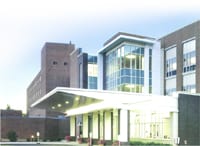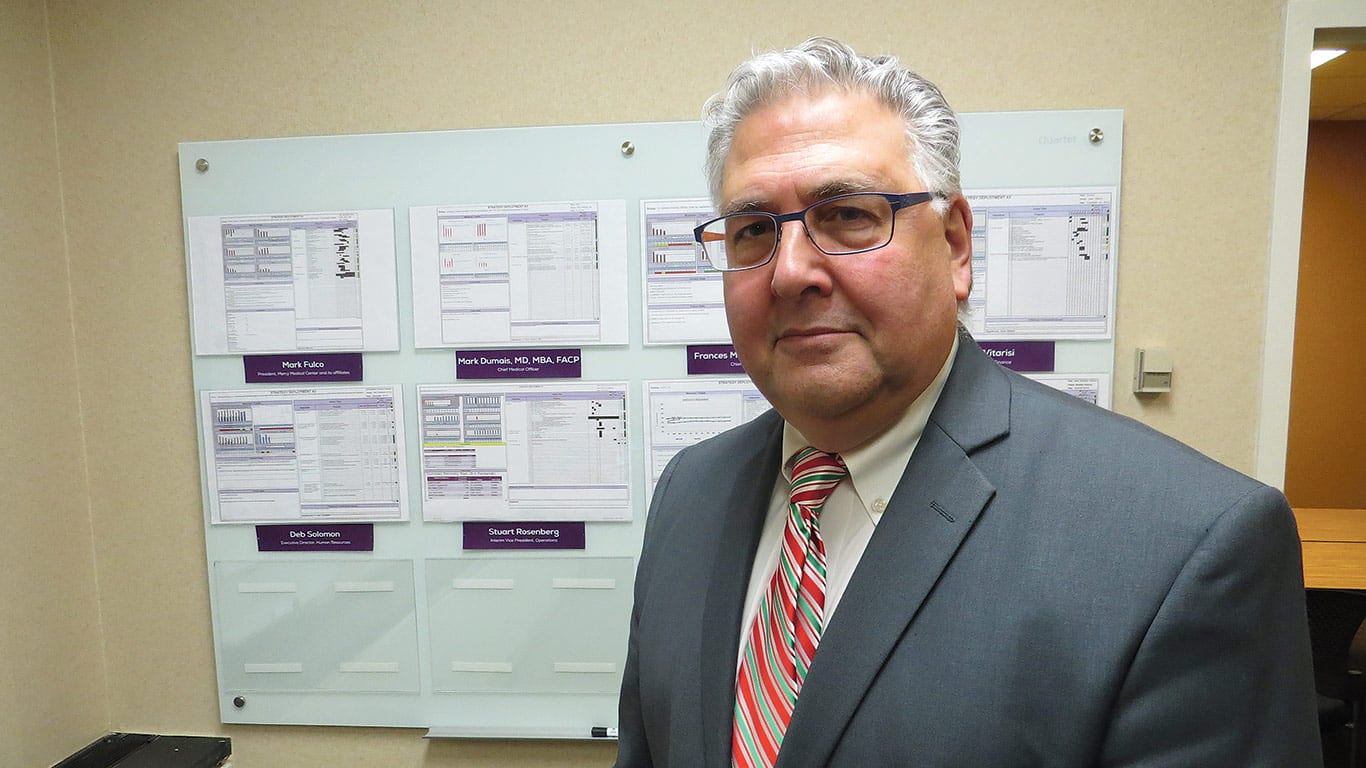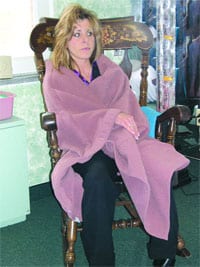All Together Now CDH’s New Cancer Center Will Focus on the Patient — and Family
Mary Ellen Walsh says that, when it comes to the treatment of cancer, Cooley Dickinson Hospital takes a distinct approach to patient care.
“I always tell our staff that, when you talk about cancer,” she told the Healthcare News, “you’re not just talking about the patient, you’re talking about the family.”
To help better serve those patients and families, CDH has embarked upon a $15 million capital campaign to build the area’s newest cancer center, to consolidate the hospital’s existing treatment facilities and programs into a unified and centralized one-stop location within the building.
Walsh is CDH’s Cancer Care Program director, and at this early stage of planning, she told HCN how this facility is going to be a great asset for a community hospital.
“We are a huge presence in this community,” she said, explaining that CDH has expended great effort assessing the role of a top-notch community hospital — and meeting that role. “What we should invest in, what is best for its community members, and what we can provide and do excellently in that community — these are all the things people might go off to a large center for.”
In approaching treatment for the disease, she highlighted the importance of family and community in the planning of the CDH cancer center. “One of the things we know from research in how people cope through cancer,” she said, “is that those who live with the diagnosis have high levels of stress, even more for those that don’t have a support system close by — whatever it might be, family, friends, or church.”
Involving all of those people in patient care is a key to CDH’s approach.
Not only is a consolidated facility important for patients and families, it plays a key role in a physician’s ability to have direct communication with all colleagues in contact with those individuals.
Dr. George Bowers is CDH’s medical director for the Cancer Care program, and he said that, by combining these specific resources, “care is a lot easier and more coordinated.”
“At this point, there are a lot of services at CDH,” he continued, “and they do provide excellent care for patients, but the realization of the center will be that the people involved in all these services will be in one geographic area, so patients and staff will have quicker transit back and forth when we are doing combined-modality therapy.”
While this commitment to cancer care is not a new phenomenon at CDH, the forthcoming center promises to be a first-class primary facility offering direct access to the best medical treatment within the community. Sitting down with HCN at the beginning of what promises to be an exciting new chapter for CDH, Walsh described how the cancer center will play an important role for both the hospital and its hometown.
Joining Forces
CDH has, over the past year, expanded its technology for cancer care, purchasing what is known as the Elekta Synergy linear accelerator. This device more accurately targets tumors with diminished risk to the healthy surrounding area. The latest word in radiation therapy, it is the same machinery in place at Mass General Hospital’s Cancer Center.
With the advent of this equipment came the realization that many of the supporting pieces of world-class cancer care were all under one roof. The challenge, Walsh said, was in how a community hospital, one with both ties to and goals for its surrounding population, can best serve those people needing treatment for cancer.
“Radiation therapy is an everyday treatment, for anything from two weeks to eight weeks, with six being the most common,” she said. “That’s every day, Monday through Friday.”
Each of those visits might last only 30 minutes, she added, but with such a commitment, lives can become complicated. There are those who may be fortunate to have work or family schedules that can accommodate the daily appointments, but for some, that might not be as simple.
“If you live 100 miles away, you would have to take a leave of absence,” she said. “If you’re lucky enough to get paid during that time, great, but I don’t think that’s the norm.
“The cancer center itself has been a dream of ours for some time,” she explained, “to have a consolidated area, but more importantly, a chance to pull all our programmatic pieces together in one area.
“So why would you want to put all these services together?” she continued. “Well, one reason is access for patients. Patients and families can come in, see their doctor, and potentially see a specialist that came to them. It’s a place that’s close to our imaging services, so that patients aren’t walking all across the hospital trying to coordinate those services.”
The cancer center doesn’t require the construction of a new building or wing at CDH. Rather, the facility will be renovated from space above the existing radiation oncology department. While much of the key programming does exist already within CDH, Walsh explained how the whole will be greater than the sum of its parts. The goal is for a welcoming environment.
“We’re interested in one place where people walk in and are comfortable,” she said, describing it as “a little less clinical-looking. You still have to come to the hospital, but you want to set it up in such a way that they will be more comfortable in the time they spend here.”
In addition to the combined cancer treatments in one place, the center will offer valuable support systems as adjuncts to patient care. There will be an area for complimentary therapies like massage or therapeutic touch; an area for patient-education programs and support groups; pastoral care, with spiritual needs an integral component; and, importantly, a patient library.
“We live in a very educated community, and at the hospital we believe in empowering our patients,” Walsh explained. “It’s not just words when we say that the patient is part of the health care team. The patient is number one. Not that they can be the physician, but in the end, it’s the person living with the disease that makes the final decision — so they need to know all the things that go into that decision-making. The patient is at the center.”
A Family Affair
Walsh reiterated the importance of family and community in CDH’s approach to cancer care.
“Family members, which can often be close friends, are a vital part in the healing process,” she explained. “By having the best care that can be provided in a community-hospital setting, keeping people close to home, along with their support systems, this all only proves to be better for the patient in that it is safer, in how the health care team communicates with each other, and it’s more efficient, especially for the patient, but also for the staff.”
And in the early days of the planning process, CDH received a generous bequest keeping in line with that commitment to their hometown.
Ernie and Marge Vitkauskus were born, raised, and lived their lives in Northampton. When Marge passed away in 2007 and Ernie in 2010, the couple bequeathed $1.7 million to the hospital. From their strong desire for a legacy at the hospital where Marge worked, the couple also recognized CDH’s first radiologist, Dr. Thomas J. Crowe. In 2010, the Vitkauskus Crowe Radiation Oncology Suite was named.
“They understood and felt strongly about the importance of being treated in their community,” Walsh said.
CDH is the latest area hospital to add a cancer center to its programming, and locally, the movement for centralized cancer treatment has been in place since Baystate Health opened the D’Amour Center for Cancer Care in 2004, followed by Mercy Medical’s Sister Caritas Cancer Center.
At CDH, Bowers said that the new facility isn’t a new way of treating cancer, just a new way to make treatment easier and more efficient for his colleagues, and thus better for patients.
“We have always had a combined-modality approach, where all those physicians involved in the care of someone with cancer talk with each other,” he explained. “Certainly, we can do a lot of communication right now, but it will be easier to have people right there, just a short walk away, rather than trying to call them.
“Ultimately, it’s easier for all the caregivers to discuss how best to take care of the patients and families,” he added.
Walsh said that the new center gives the hospital a competitive boost as a community resource, and the technology and services will offer the best possible care. And to her, that’s important not only as the director of the new facility, but as a member of that community.
“One of the things we say all the time,” she told HCN, “is that what we do, we take very seriously, because we treat our own families, neighbors, and friends. And that is a privilege.
“So how good do you think we want to be if your mom is treated here, or your best friends, or the person you went to high school with?” she asked. “We want to be excellent, and we are.”



